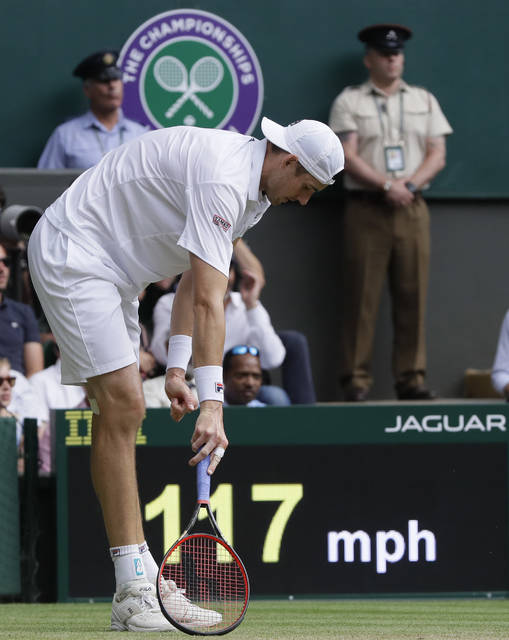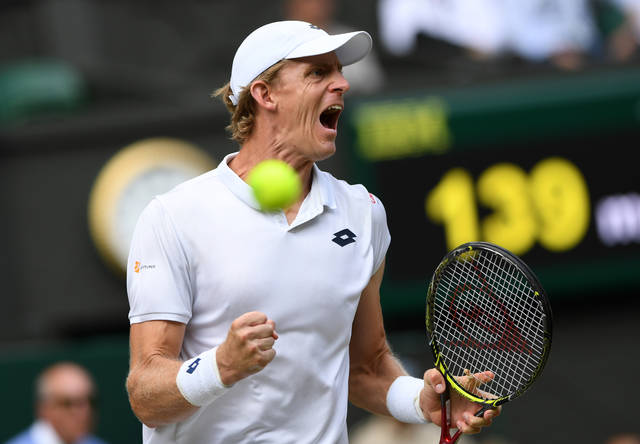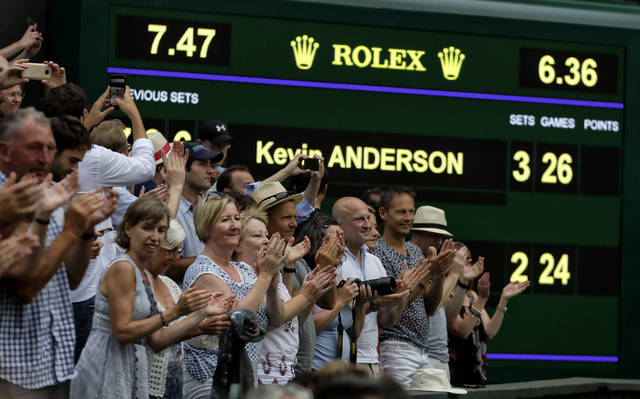LONDON — To say that Kevin Anderson won this interminable Wimbledon semifinal, and that John Isner lost it, didn’t really seem fair. To Anderson, anyway.
They had played on and on, through 6½ hours of ho-hum hold after ho-hum hold, during the second-longest match in the history of a tournament that began in 1877, all the way until the never-ending serving marathon did, finally, end at 26-24 in the fifth set Friday, with Anderson claiming the most important of the 569 points — the last.
So when Anderson left Centre Court, well aware that his 7-6 (6), 6-7 (5), 6-7 (9), 6-4, 26-24 victory earned him the chance to win his first Grand Slam title at age 32, the South African said: “At the end, you feel like this is a draw between the two of us.”
He continued: “John’s such a great guy, and I really feel for him, because if I’d been on the opposite side, I don’t know how you can take that, playing for so long and coming up short.”
Only one match at Wimbledon lasted longer: Isner’s 2010 first-round victory over Nicolas Mahut, the longest match in tennis history. It went more than 11 hours over three days and finished 70-68 in the fifth on Court 18, which now bears a plaque commemorating it.
Friday’s fifth set wasn’t quite as long, but still, it lasted nearly 3 hours as the semifinal became a test of endurance more than skill.
“He stayed the course incredibly well,” said the No. 9 seed Isner, a 33-year-old American playing in his first major semifinal. “Just disappointed to lose. I was pretty close to making a Grand Slam final and it didn’t happen.”
Anderson finally earned the must-have, go-ahead service break with the help of a point in which the right-hander tumbled to his backside, scrambled back to his feet and hit a shot lefty.
“That definitely brings a smile to my face,” Anderson said. “At that stage, you’re just trying to fight in every single moment, and I was like, ‘Just get up!’”
The No. 8 seed Anderson eliminated eight-time Wimbledon champion Roger Federer in a 13-11 fifth set in the quarterfinals Wednesday. Between that and the energy-sapper against Isner, it’s hard to imagine how Anderson will have much left for Sunday’s final, his second at a major.
Anderson was the runner-up to Rafael Nadal at last year’s U.S. Open. There could be a rematch now. Anderson’s opponent for the title will be Nadal or Novak Djokovic, who began their semifinal after 8 p.m. on Friday evening. Because it was so late, the All England Club shut the retractable roof above the main stadium between the matches and turned on the arena’s artificial lights.
Wimbledon doesn’t use tiebreakers in the fifth set for men, or third set for women, so there’s nothing to prevent a match from continuing ad infinitum. Both Isner and Anderson said they’d like to see that change.
“It’s long overdue,” said Isner, who suggested changing the rule to using a tiebreaker at 12-all in the fifth set. “I’m a big part of that, and a big part of this discussion, of course.”
At one point in the fifth set, a spectator shouted, “Come on, guys! We want to see Rafa!”
The 6-foot-8 Anderson and 6-foot-10 Isner go way back, to their college days, Isner at Georgia, Anderson at Illinois. In the pros, Isner had won 8 of 11 previous matchups. But this one was as close as can be.
There wasn’t a whole lot of intrigue, or momentum shifts. Not a tremendous amount of memorable shotmaking, either, save for some impressive return winners.
And the serving? Well, that was something else. Isner pounded his at up to 142 mph; Anderson reached 136 mph. They combined for 102 aces: 53 by Isner, 49 by Anderson.
“The effort they both put in and the performance and the guts, the way they competed — a lot to be proud of,” said Justin Gimelstob, one of Isner’s coaches.
Both failed to seize early opportunities. Isner wasted a set point in the opener. Anderson served for the third at 5-3, got broken, then had a pair of set points in that tiebreaker, double-faulting one away.
By the latter stages, with break chances so rare, murmurs would spread through the Centre Court stands whenever a game’s returner got to love-15 or love-30.
Could he actually come through?
Could this be it?
Could we be about to see the sixth and last break of a match that would end up with 90 holds?
Repeatedly, the answer was, of course, “No,” even when Anderson held break points at 7-all, 10-all and 17-all. The 10-all game ended with Isner hitting a forehand passing winner on the run to hold, then letting his momentum carry him directly to his sideline chair, where he plopped himself down.
By the end, he was looking exhausted, leaning over to rest a hand on a knee between points.
“I feel pretty terrible,” Isner said afterward. “My left heel is killing me and I have an awful blister on my right foot.”
He never got a break point in the fifth set. Anderson finally came through on his sixth for a 25-24 lead, when Isner wearily put a backhand into the net.
Then Anderson served out the victory, with Isner sailing a forehand wide on match point.
Soon, they were meeting for an embrace.
———
Follow Howard Fendrich on Twitter at http://twitter.com/HowardFendrich
———
More AP tennis coverage: https://www.apnews.com/tag/apf-Tennis




